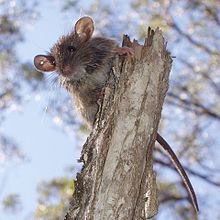Bush rat
| Bush rat | |
|---|---|

| |
| Scientific classification | |
| Kingdom: | |
| Phylum: | |
| Class: | |
| Order: | |
| Family: | |
| Subfamily: | |
| Genus: | |
| Species: | R. fuscipes
|
| Binomial name | |
| Rattus fuscipes (Waterhouse, 1839)
| |

| |
| Distribution on subspecies-level: red=R. f. fuscipes; green=R. f. greyi, blue=R. f. assimilis, brown=R. f. coracius | |
The bush rat (Rattus fuscipes) is a small Australian nocturnal[1] animal. It is an omnivore. It is one of the most common species of rats and is found in many heathland areas of Victoria and NSW. While there are not many characteristics that distinguish the bush rat from other Rattus species, it is characterized by having a small tympanic bullae and a straight incisive foramina. Adult bush rats are smaller than the Australian swamp rat (Rattus lutreolus) and in addition, the bush rat's foot pads are a pink colour, whereas the swamp rat's foot pads are dark brown.[2] The feet are pentadactyl with all digits clawed. The bush rat exhibits sexual dimorphism; the males are larger than the females in the species.
Distribution and habitat
Bush rats first arrived in Australia in the second wave of rodent migration, around two million years ago.[3][failed verification]
The bush rat is found primarily in the coastal regions of southwestern Australia. While it is mainly found in the lowlands, the bush rat can also be found in parts of the Australian Alps and on some offshore islands.
The bush rat is primarily a burrower, the burrow leads down into the nest chamber and is lined with grass and other vegetation.
Diet
The bushrat doesn't show much overlap in diet with other local rodent species. In the summer it consumes primarily fruit, arthropods, and seeds, but in the winter its main source of food is from a particular cyperaceous species. When found in the forest it consumes primarily fungi and various fibrous plant material.[4]
Behavior
General behavior
The bush rat is strictly nocturnal and is active year-round. Adults seem to be nomadic, but will rarely leave the forest floor. The bush rat was once considered to be solely a herbivore but recently it has been discovered that it is an omnivore. It is considered to be a pest species because it can destroy cane fields. It is also the host to more parasites than any other Australian rodent. They exhibit stereotypically normal behavior when approaching an intruder; boxing, threat-posture, clash, approach.
The bush rat is prey to some local predators, including; dingoes (Canis familiaris) and Foxes (Vulpes vulpes), and non-mammalian predators such as; avian raptors and reptiles.
Breeding behavior
The bush rat (Rattus fuscipes) begins breeding around November and has litter sizes ranging usually between 4-5. The majority of individuals do not live to a second breeding cyle due to their short life span.[5] The gestation period of the bush rat varies between 22 and 24 days. The "nursery" of the bush rat is its burrow. The nursing period lasts for about the first 20–25 days of life.
External links
Notes and references
- ^ WIRES
- ^ Communitywebs.org
- ^ Parks and Wildlife Service, Tasmania
- ^ Cheal, DC (1987). The Diets and Dietary Preferences of Rattus-Fuscipes and Rattus-Lutreolus at Walkerville in Victoria. Australian Wildlife Research 14, 35–44.
- ^ Wood, DH (1971). The ecology of Rattus fuscipes and Melomys cervinipes (Rodentia : Muridaae) in a south-east Queensland rain forest. Australian Journal of Zoology 19, 371–392.
- Template:IUCN2006
- "Bush Rat Fact File". Wildlife of Sydney, Australian Museum. Archived from the original on 5 January 2005. Retrieved 14 February 2005.

